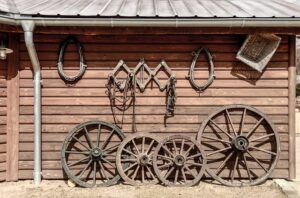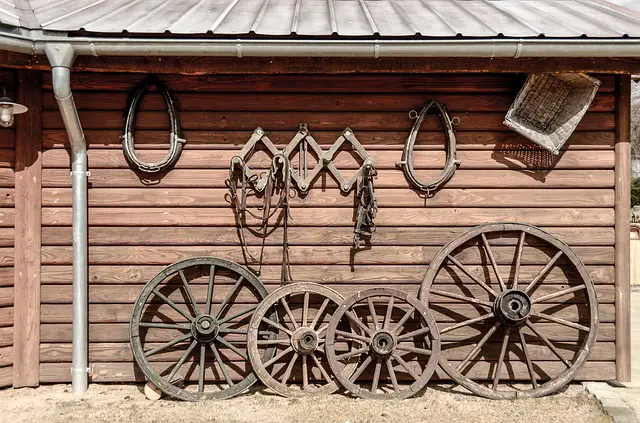
The wheel is the fundamental instrument in today’s transportation system, as well as so much more.
The invention of the wheel has become a literary cliché referring to prehistory, but was there an inventor for the wheel?
We do have “the oldest wheel ever discovered.” A wooden wheel was found 12 miles (20 km) southeast of Ljubljana, Slovenia that is estimated to be over 5,000 years old.
But what about the development of the wheel?
The wheel was invented in Mesopotamia, and it has been used to transport goods ever since. It’s the world’s oldest known use for transportation, dating back more than 3,000 years.
Sumerian Ur, located in modern-day Iraq, had a stone potter’s wheel built around 3129 BC and fragments of wheel-thrown pottery have been found in the same region dating back to around 4000 BC.
Who invented the wheel?
Historians and archaeologists are still unsure, but it is generally accepted that the Sumerians were the first to develop the potter’s wheel.
This was an important invention because it allowed them to produce large quantities of pottery for everyday use.
The wheel has been adapted for many different purposes over the years. It was first used to transport goods, but it has also been used in warfare, agriculture, and even medicine.
Today, the wheel is an essential part of our transportation system and is used in cars, trains, planes, and boats.
The wheel is an essential part of our transportation system and is used in cars, trains, planes, and boats.
When was the wheel invented??
The wheel was invented in Mesopotamia around 3,000 BC. Let’s take a look at the history of how it developed after its invention.
As with all inventions, the wheel didn’t appear fully formed when it was first created. It evolved over time and through many different civilizations until it reached almost perfection by the 1900s.
Here’s a brief history of the wheel’s development.
Sumerian Ur
The first known use of the wheel for transportation was in Sumerian Ur, located in modern-day Iraq. A potter’s wheel was built around 3129 BC and fragments of wheel-thrown pottery have been found in the same region dating back to around 4000 BC.
China
The first recorded use in China was around 1200 BC and the oldest surviving example of a wooden wheel with spokes can be found in one of China’s ancient tombs from about 200 AD.
Egypt
Egyptian art from 2000 BC depicts four-spoke wooden wheels on sleds. This predates Sumerian records by at least 500 years.
India
The earliest records of wheeled carts in India were found on rock carvings near Bhubaneshwar, Orissa (ancient Konark), which are dated to the 4th century BC.
The Rig Veda tells of the Battle of Ten Kings when they used chariots with scythes on the wheels.
Greece and Rome
The Greeks and Romans were some of the first to use the wheel for transportation on land. They developed chariots, wagons, and carts that were used in warfare, agriculture, and trade.
Europe
The wheel began to be used in Europe around 500 AD and quickly became an essential part of the transportation system.
America
The wheel was first used in America by the Native Americans who developed wagons and carts for transportation and trade.
Australia
The wheel was introduced to Australia by the British settlers in the early 1800s and quickly became an essential part of the transportation system.
The wheel has come a long way since it was first invented in Mesopotamia more than 3,000 years ago.
It has been used in transportation, warfare, agriculture, and trade and is an essential part of our modern-day transportation system.
Who would have thought that a simple potter’s wheel would have such a long and important history?
The Wheel in Mythology

The wheel has been around for so long and is so widespread that it is no wonder that it has become woven into mythology in many cultures around the world.
Chinese myth
A Chinese myth talks about a terrible monster called Nian that was unable to eat cattle and people because they were protecting themselves with weapons and fire.
One day, a curious boy saw Nian and thought he would just touch him instead of running away.
The brave boy turned into an iron wheel before he could be eaten and rolled away, dragging Nian into the light of day where he was eaten by other animals.
Hindu myth
A Hindu myth tells of the god Vishnu in cosmic sleep on a great serpent floating in an infinite ocean.
In his dream, a lotus flower sprang from Vishnu’s navel and grew into a giant world tree that held all the worlds within it. There was a lotus flower at the bottom of the tree.
Vishnu sent one of his servants down to see if the world was ready for him to awake. The servant found that it wasn’t, so he picked all but one of the flowers and returned them to Vishnu who floated back up into his dream.
Stories like these show how the wheel has become an important part of mythology in many cultures around the world.
It is a simple object that has had a profound impact on human civilization.
- Related post: The history Of How Cars Were Invented
- Related post: How was the first airplane invented
What are the benefits of the wheel?
The wheel has a number of advantages over other forms of transportation. It is very efficient and can transport large loads over long distances.
It is also easy to operate and does not depend on a skilled operator, which is important in a society where transportation can be difficult.
The first wheeled vehicles were made from logs and had no suspension so they caused a bumpy ride for the passengers. Later, wheels were made with spokes to improve the comfort of the ride.
Carts have been used as weapons throughout history as a rapid and effective way to launch attacks and spread fear in the enemy.
The most famous example is probably Hannibal’s war elephants in 218 BC against Rome.
Modern day highways wouldn’t exist without wheels either, as they would be impractical to build over large areas. Wheels allow us to travel very quickly which has had a profound effect on cities around the world.
We can see that the wheel has a number of advantages over other forms of transportation and has had a significant impact on human civilization.
It is an essential part of our modern-day transportation system and I’m sure it will continue to play an important role in the future.
Conclusion
A wheel is a simple object that has had a profound impact on human civilization. It is an essential part of our modern-day transportation system and I’m sure it will continue to play an important role in the future.
Thank you for reading! I hope this article has given you a better understanding of the history and benefits of the



